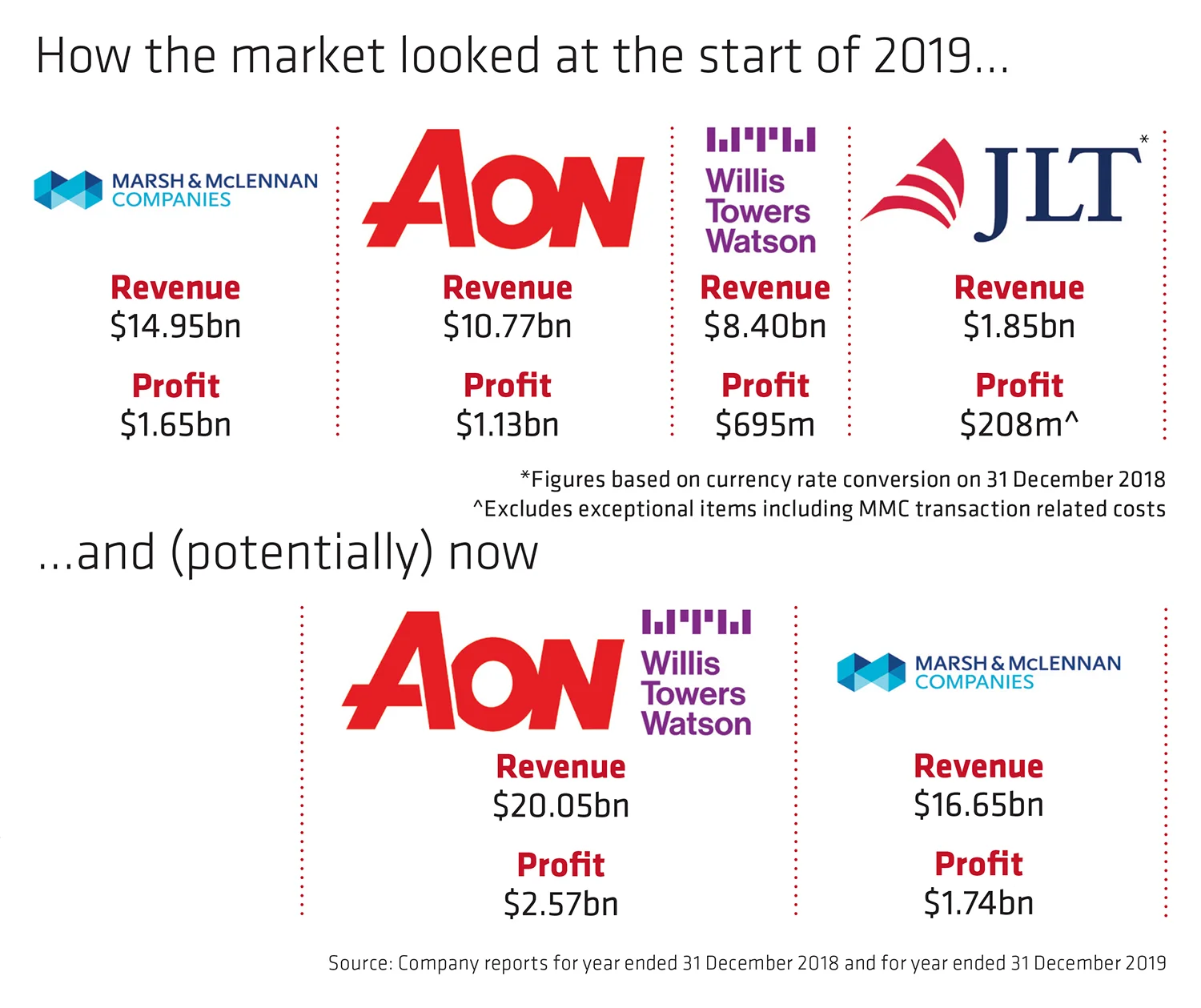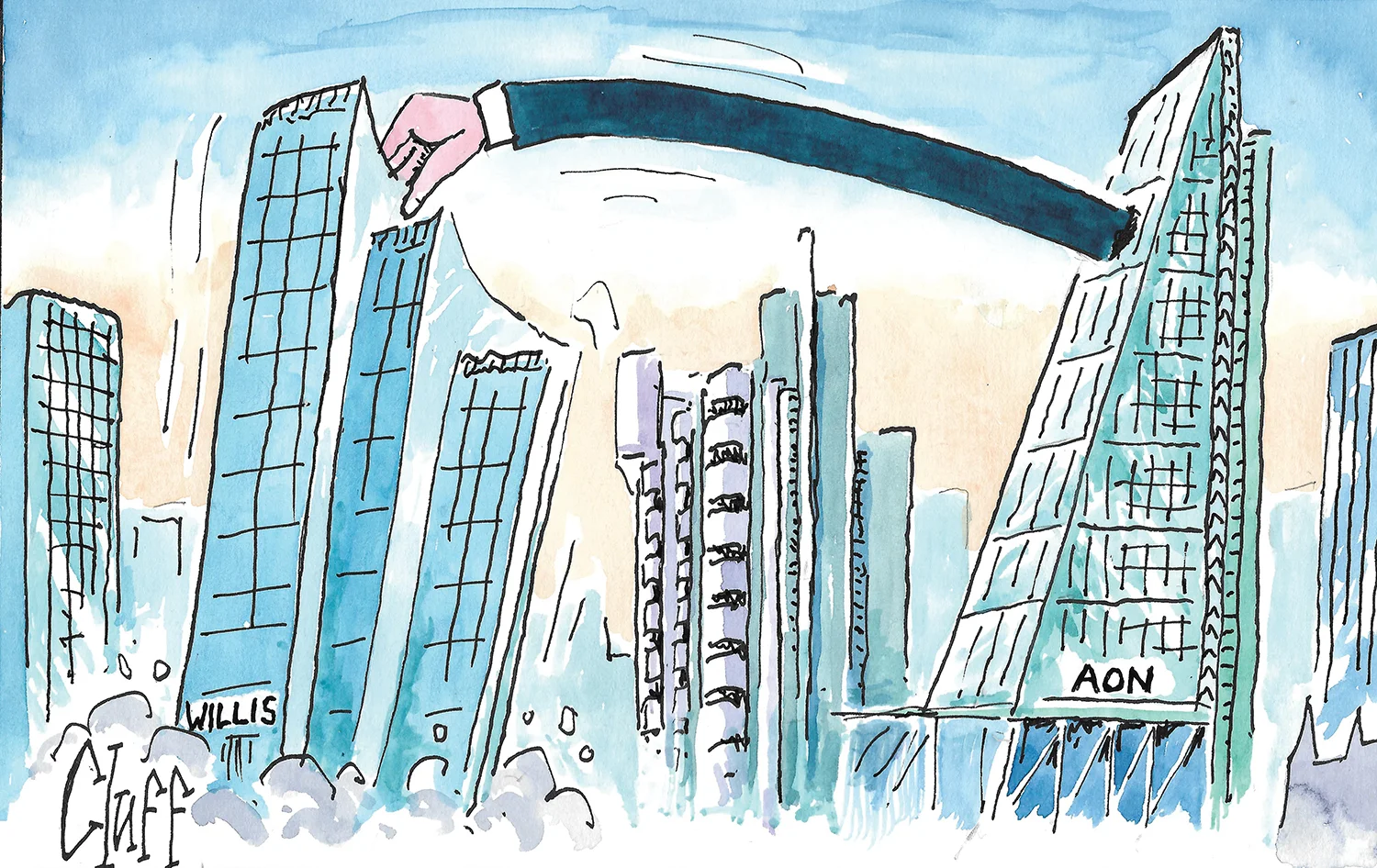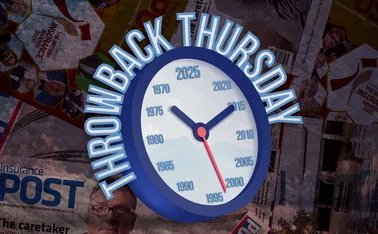
Analysis: Risk manager associations downbeat on Aon-Willis takeover

Need to know
- Risk management associations voice concerns about reduced choice
- Disposals will be needed to get the deal over the line, say experts
- Willis Re touted as a likely divestiture
- Opinion split about how the deal could enrich the regional UK broker market
Post gathers feedback from across the industry on what Aon’s takeover of Willis – to create the biggest broker in the world – will mean for the market
Risk management associations have bemoaned the reduction in choice after Aon’s near $30bn (£22.4bn) all share takeover of Willis Towers Watson was unveiled on 9 March.
The deal is due to complete in the first half of next year and would create a combined entity worth $80bn based on share prices at the time of the announcement (see In Numbers). It would trade under the Aon brand.
In Numbers
$29.9bn WTW value based on 6 March closing share price
$80bn New combined entity value
Based on 2019 results combined group would have:
Total revenue of $20.1bn
Around 95,000 employees
Adjusted operating income of $4.9bn
Projections over three years:
$800m of annual pre-tax synergy savings
$1.4bn of integration costs
$400m of retention costs
The announcement came almost exactly a year after the two parties abandoned previous merger talks and less than a year since Marsh & McLennan Companies completed its $5.6bn JLT buy.
John Ludlow, Airmic CEO, told Post that the reduction in choice was disappointing and that members would have strong views on it.
“It is not yet clear at all what value this merger will bring to our members, and they will challenge the newly created broker to demonstrate, not just in words but in actions too, how it is going to offer increased value in exchange for more limited choice,” he commented.
According to Ludlow brokers are already increasingly homogenous in culture and constrained by regulation, both of which can lead to a reduction in service, creativity and diversity.
“If customer value fails to materialise, policyholders will undoubtedly find new ways of fulfilling their needs,” he predicted.
Increasing commoditisation
Alessandro De Felice, president of Anra, the national risk managers association in Italy, said it was hard to understand the customer benefit of the Aon-Willis deal and that it seemed to confirm his perception of increasing commoditisation in the market.
“It appears that the business for brokers is to concentrate the higher possible mass of premium to get better remuneration from insurers by moving entire portfolios with a constant deteriorated quality service level to customer and a not clear value proposition,” De Felice commented to Post.
He argued that customers need advice and data analytics instead of a larger placing broker.
Like Ludlow he pointed out: “Corporations may reconsider their strategy and relationship in favour of smaller broking firms that may offer a much more tailored and accurate service as well as being concerned about the concentration of business and less competition.”
Dirk Wegener, president of the Federation of European Risk Management Associations, said maintaining customer choice was the principal concern for European corporate risk and insurance managers. “We understand the reasons for consolidation in the industry, and we appreciate the investment in expertise that size makes possible,” he stated.
“At the same time, corporate insurance buyers want to know they can get different views and that they are getting the best value for money.”
Ludlow highlighted Willis Group merging with Towers Watson as an example of the benefits of consolidation with wider access to specialist risk management practices a positive for members.
Broad spectrum of needs
For the Aon-Willis merger to be successful the broad spectrum of needs and wishes of policyholders must be at the heart of its strategy, he continued, saying they cannot be treated as the end point of a transaction. “We look forward to seeing where the new sources of value will lie,” Ludlow concluded.
The most upbeat response was from North America’s RIMS, risk management society. CEO Mary Roth said both Aon and Willis Towers Watson have been “tremendous champions for RIMS and the risk management community”.
But she also flagged that risk professionals rely on insurance partners to innovate and offer competitive solutions to build resilient risk programs.
“Our hope is that the new combined entity continues to deliver excellent products and services to the risk management community as they did apart,” Roth concluded.
According to Mazars the Competition and Markets Authority will look at the deal.
“Speculation already abounds that some of the combined divisions will need to be spun-off to appease the CMA as the market options for clients are compressed even further by this merger following that of Marsh and JLT only a year ago,” said director Simon Fitzsimmons.
As part of Marsh’s acquisition it had to sell JLT’s aviation business to Gallagher for £190m to address European Commission concerns.
One lawyer who declined to be named said that there would certainly be disposals to get Aon and Willis to completion.
“The bottom line is they will have identified this,” he observed adding that M&A lawyers and competition advisors would already have advised them on the risks and “show-stoppers”.
Rating agencies respond to the deal
Fitch Ratings placed the BBB+ long-term issuer default ratings and outstanding debt of Aon and its subsidiaries on a negative watch.
It said the action reflected “the significant deal size, material execution risk, and uncertainty surrounding the regulatory outcome and Aon’s ultimate long-term capital plan”.
Moody’s Investors Service affirmed the Baa2 senior unsecured debt rating and stable outlook of Aon. It also affirmed the Baa3 rating for WTW and changed the outlook from stable to positive. The agency said that it expected the combined group “will maintain credit metrics consistent with Aon’s current levels”.
S&P put WTW’s BBB rating on a positive watch. It kept Aon’s A- rating with a stable outlook. The researchers said that if the transaction closes as announced it will likely equalise WTW’s rating with Aon’s.
“We think that if this deal closes, it has the potential to enhance Aon’s business profile by strengthening its middle-market presence significantly while enhancing its overall scale, product depth, and operational capabilities,” S&P reported.
Willis Re has been the division most touted for a sale. WTW does not provide a breakdown of revenue for the unit but calculations range from $685m to $735m.
As one anonymous broker put it: “If Willis Re expertise became available there would be appetite in the market to take up that capacity, it is a talented team.”
Aon Reinsurance Solutions posted revenue of $1.69bn for 2019 while MMC’s Guy Carpenter achieved $1.48bn.
According to a prominent reinsurance expert: “It [the CMA] is going to have to do something otherwise you are down to two major brokers.
“Together they are something ridiculous like 70% of the market, probably even more.”
Gallagher has been tipped repeatedly as a potential buyer. Other sources have suggested Ardonagh, Hyperion and McGill & Partners but also qualified that these may prefer to grow into the market. “It is ready made to make you one of the big three,” the reinsurance specialist pointed out.
Along with approval from competition authorities and regulators in almost 100 jurisdictions around the world, shareholders also still need to give their blessing.
“I can see the deal not happening,” said Richard Hodson, director at UK Global Broking Group. “I don’t see the major benefit to either company at this stage. There is nothing that the other cannot do.”
If the deal does go ahead everyone expects considerable fallout.
One broker leader noted that with the firms’ management forecasting $400m will be needed for retention, they must believe there is a risk of losing staff they want to keep. On top of this another $1.4bn of integration costs is predicted to create $800m of annual pre-tax “synergy savings” after three years.
“That is going to be an awful lot of people and process coming to market,” he stated adding that with people moving “you can bet clients are going to be moving as well”.
Deepening the pool
Opinion though is divided on just how enriching this will be for the regional UK GI broker market.
The unnamed broker predicted that regionals and networks will do “really well” from recruitment and people setting up on their own respectively.
“It broadens the intellectual pool [bringing] experience, knowledge and access to new markets underwriters and capacity,” they argued. “It is incredibly refreshing for the regional broker market.”
However, a broker competitor, who also declined to be named, disagreed.
“Retail is a very different space,” they said in contrast.
“What are people going to bring in?” they questioned. “It can be quite irritating when you work in a small brokerage and someone comes in from the London Market and thinks they know it all.”
Where both agreed was that there was an element of ego in the merger.
“There will be strands of human nature in the boardroom,” one suggested predicting an “aggressive battle” between the enlarged Marsh and Aon entities with “jockeying for global supremacy”. The other concurred: “There is pride in this,” they maintained. “Aon has lost its number one position.”
Scale though will only do so much with insurers that have to maintain their own profitability.
“What I’d would like to know is why it has chosen Willis,” said David Williams, managing director of underwriting and technical services at Axa Insurance.
“Is it because it sees things like Willis Network which is quite successful, is it the consultancy side which Towers Watson brings, or is it just it wanted to compete on size?”
Consolidation in the regional market often leads to larger players buying up smaller brokers and bundling them into a better paying arrangement with insurers so the acquisition pays for itself. Williams was adamant that there was “not a chance” of similar uplifts here.
“We are talking about two of the largest brokers in the UK. Believe me they will have squeezed as hard as it is possible to squeeze and there is no more commission available.”

Different mindset
As one of the broker specialists concluded, focusing on the $80bn equity value of the combined organisation is using the wrong lens and a different mindset is needed.
“Big enough to deliver in the range of client services for existing and future needs of the clients while having the conscience in the business to give great service and care,” they concluded.
Just being big then isn’t enough.
For future generations to look back on this as a success it has to be seen to have created increased intellectual pools, specialisms, sophistication and an ability to deal with catastrophe events for the benefit of clients. In other words, to have met the demands of Airmic, Anra and many others.

Only users who have a paid subscription or are part of a corporate subscription are able to print or copy content.
To access these options, along with all other subscription benefits, please contact info@postonline.co.uk or view our subscription options here: https://subscriptions.postonline.co.uk/subscribe
You are currently unable to print this content. Please contact info@postonline.co.uk to find out more.
You are currently unable to copy this content. Please contact info@postonline.co.uk to find out more.
Copyright Infopro Digital Limited. All rights reserved.
As outlined in our terms and conditions, https://www.infopro-digital.com/terms-and-conditions/subscriptions/ (point 2.4), printing is limited to a single copy.
If you would like to purchase additional rights please email info@postonline.co.uk
Copyright Infopro Digital Limited. All rights reserved.
You may share this content using our article tools. As outlined in our terms and conditions, https://www.infopro-digital.com/terms-and-conditions/subscriptions/ (clause 2.4), an Authorised User may only make one copy of the materials for their own personal use. You must also comply with the restrictions in clause 2.5.
If you would like to purchase additional rights please email info@postonline.co.uk








